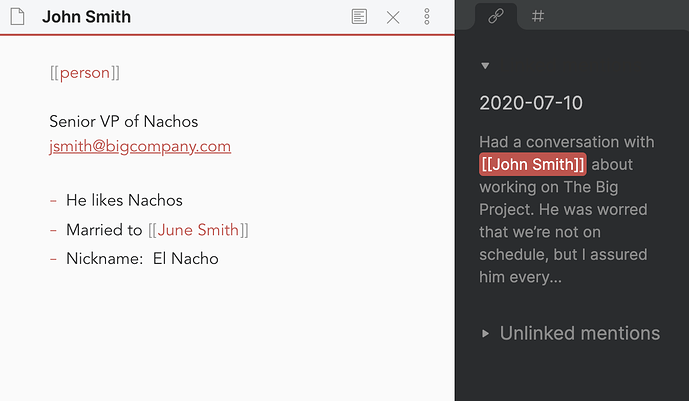I use Daily Notes as the backbone of my KMS. The reason is that I find time to an important context for storing information. “When I do something” can be just as important as what I do.
I’ve configured my Daily Notes plugin like this:
Here are some details:
- The
Date Formatis configured to give me the first three characters of the day. For me, this is important because I tend to remember things by what day I did them rather than the date. In my example, my note titles look like2020-07-10_Fri - I store all my daily notes in separate folder from my archive. I have tried (and mostly succeeded) at removing folders as an organizational construct in my KMS, but given the sheer number of notes I’m going to be creating in this one format, a separate folder made sense to me. I reserve the right to change my mind in the future.
- The last line is where I store my template… and what’s that look like, you ask?
The Template
`Breadcrumb Trail`
## Tasks
## Communication Log
## Work Log
## 0000 Meeting
- Tags:
- Meeting Link:
- Attendees:
- Tasks:
- Notes:
The Breadcrumb Trail
I put that at the top of all my daily notes, so I can quickly get to the surrounding day’s notes. I do this through a text expander app called espanso. How I do it can be found here: Fun with espanso
The Task List
This is a list of tasks that I need to accomplish. Any task that I don’t complete this day, gets manually copied to the next day. That in and of itself isn’t that special, but I have a couple of processes that help me keep track of things over time.
The first is the use of a Shame Meter. Every time I carry a task forward, I add an ! to it. The more times a task gets deferred, the more !!!! build up.
The second trick involves backlinking. If there’s something that I plan to do another day, I include a link to that day’s daily note. When I finally get to that day, there will be a backlink to the task waiting for me. I don’t carry these tasks forward like the other tasks because I’ve already decided when I want to act on it.
As I move through my week and check off tasks, I have a running record of what I did and when based on where it got checked off on my daily notes.
The Communication Log
I keep a record of almost every conversation I have with people in which I share some sort of responsibility. This includes Slack messages, emails, phone calls or in person. I briefly summarize what we talked about and include any thoughts I have about the conversation in the moment.
Again, this isn’t that special, but again, I have a cool trick: I create personal notes for everyone I communicate with. This allows me to keep a database of my interactions with them. For example:
My note for John Smith contains things I know about him and the backlinks include every time I’ve mentioned him. If on a daily note, the title of the note tells me when I talked to him and what it was about.
The Work Log
This is pretty self explanatory. I simply link every note I worked on that day. The side effect is similar to the Communication log. If I work on a note (read: Project) for more than one day, the backlinks for that note include a timeline that could be interpreted as a level-of-effort for a particular project. It’s not as detailed as a proper time-tracking app, but it works for me.
The Meeting Block
At the beginning of every day, I create a Meeting block for every meeting on my calendar. I do this with espanso. This section is also pretty straight forward but here are a few details:
- Tags: This is where I link notes that pertain to this meeting. I also add tags if I feel I need to come back to this via search or I want to bundle this meeting with other thoughts.
- Meeting Link: The Zoom/Hangouts link, just in case I get disconnected
- Attendees: A link to every person in the meeting, when it makes sense. For example, I don’t link to everyone in a large departmental meeting. That would be ridiculous.
- Tasks: If the tasks doesn’t get done or is not deferred, it gets added to tomorrow’s Task list.
Daily Routine
- My daily notes are pinned, so first thing in the morning, I click the “Daily Note” button and it copies my template and opens right next to the previous day’s pinned Daily Note.
- I use espanso to create the breadcrumb trail
- I scan yesterday’s daily note for Tasks that didn’t get completed or deferred. Those get copied into the Tasks section and I increase the Shame Meter
- I check the backlinks for anything that’s been deferred to today and copy them into the task section.
- Check my calendar for meetings, create a meeting block (with espanso) for each one and fill out any information that may be pertinent (e.g links to projects, the Zoom meeting link)
- I pin the today’s Daily Note and close yesterday’s
Future Updates
I’m working on a python script (that may one day be a plugin) that will monitor Daily Notes for uncompleted tasks and forward them to a legit task manager application.
Conclusion
This probably doesn’t work for everyone, but it works extremely well for me. It allows me to use time as an index into my KMS and helps me from letting things fall through the cracks.




